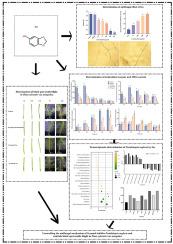芝麻酚通过破坏拟盘多毛孢氧化还原动态平衡抑制真菌生长
IF 3.3
3区 农林科学
Q2 PLANT SCIENCES
引用次数: 0
摘要
破坏细胞抗氧化系统是控制真菌病原体的有效途径。许多酚类化合物已被证明通过破坏细胞氧化还原平衡或抗氧化系统来抑制微生物的生长。Sesamol (Ses)是一种从芝麻油中分离出来的芳香酚,对多种细菌和真菌有良好的抑制作用,但其对植物病原真菌的抑制作用尚不明确。在本研究中,Ses对真菌菌丝结构造成了损伤。此外,硒还能显著抑制草甘膦过氧化氢酶(CAT)、过氧化物酶(POD)和超氧化物歧化酶(SOD)的活性。在浓度为300 μg/mL时,丙二醛(MDA)含量比对照组高1.8倍。转录组学分析显示,Ses下调了氧化还原稳态相关基因的表达,上调了膜脂过氧化相关基因的表达。综上所述,Ses破坏了忽略假单胞菌的氧化还原平衡,促进了膜脂过氧化,破坏了细胞膜的完整性,最终导致真菌细胞死亡。这些发现为Ses的抗真菌机制提供了新的见解,并突出了其作为植物源农药的潜力。本文章由计算机程序翻译,如有差异,请以英文原文为准。

Sesamol inhibits fungal growth by destroying the redox dynamic equilibrium in Pestalotiopsis neglecta
Disruption of the cellular antioxidant system is an effective way to control fungal pathogens. Many phenolic compounds have been shown to inhibit microbial growth by disrupting the cellular redox balance or antioxidant system. Sesamol (Ses), an aromatic phenol isolated from sesame oil, has good inhibition effects in several bacteria and fungi, but its inhibition activity against plant pathogenic fungi remains underexplored. In this study, Ses caused damage to the fungal mycelial structure. Additionally, Ses markedly suppressed the activities of catalase (CAT), peroxidase (POD), and superoxide dismutase (SOD) in P. neglecta. At a concentration of 300 μg/mL, the malondialdehyde (MDA) content was 1.8-fold higher than that of the control group. Transcriptomics analysis revealed that Ses downregulated the expression of genes involved in redox homeostasis while upregulating genes associated with membrane lipid peroxidation. In conclusion, Ses disrupted the redox balance of P. neglecta, promoted membrane lipid peroxidation, compromised the integrity of the cell membrane, and ultimately led to fungal cell death. These findings provide novel insights into the antifungal mechanism of Ses and highlight its potential as a plant-derived pesticide.
求助全文
通过发布文献求助,成功后即可免费获取论文全文。
去求助
来源期刊
CiteScore
4.30
自引率
7.40%
发文量
130
审稿时长
38 days
期刊介绍:
Physiological and Molecular Plant Pathology provides an International forum for original research papers, reviews, and commentaries on all aspects of the molecular biology, biochemistry, physiology, histology and cytology, genetics and evolution of plant-microbe interactions.
Papers on all kinds of infective pathogen, including viruses, prokaryotes, fungi, and nematodes, as well as mutualistic organisms such as Rhizobium and mycorrhyzal fungi, are acceptable as long as they have a bearing on the interaction between pathogen and plant.

 求助内容:
求助内容: 应助结果提醒方式:
应助结果提醒方式:


